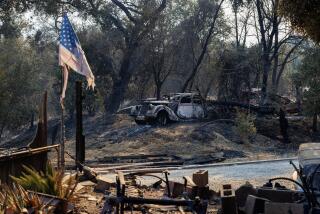What an Economy in Low Gear Means : Effects of Long Slump Could Get to Be Personal
Sometime a few years ago, the U.S. economy’s engine started to sputter. Then it did something quite out of character for the prosperous years since World War II: It kept right on sputtering--and has yet to stop.
Today the nation remains mired in an episode of sluggish growth that has rarely been matched in the last four decades if at all. The unemployment rate has risen sharply this year. And a gloomy minority of experts worries that the economy will stay grounded for a long time, with California and the Northeast on the bottom.
“If the economy normally soars like an eagle, it’s going to flutter like a chicken for a few years,” warns David A. Levy, an economist at Bard College in Annandale-on Hudson, N.Y., who calls the prolonged malaise a “contained depression.”
Such visions, of course, could prove unduly pessimistic, and most economists believe they will. Yet it’s sobering to think about what a drawn-out slump would mean to a society long hooked on the virtues of brisk growth.
Growth means votes for politicians, jobs for the jobless, profits for investors and gains in America’s standard of living. It buoys morale, promotes political harmony--as different groups in society feel secure in their share of an expanding pie--and encourages innovations in technology.
The effects get downright personal: More people get married and have kids in a growing economy than in a slump, statistics suggest. The environment, the kinds of products on store shelves, the quality of life could be affected if the economy’s blahs hang on long enough.
“The whole concept of the United States and the American dream is predicated on relatively fast growth--the idea that we will do better than our parents, and that our children will do better than we do,” observes David Brownstone, an economist at UC Irvine.
For much of recent history, despite occasional, short-lived downturns, growth has seemed like a sure bet. Lately, however, the idea and the reality seem to have diverged in important ways.
Growth petered out in the late 1980s and has yet to reliably re-establish itself. The recession began in mid-1990, but growth rates actually had become negligible a year earlier in most of the country. Since early 1991, the economy has followed an odd, stop-and-go pattern. Many fear it is stumbling again.
Even the Democratic Party, long focused on matters of social equity, now waxes earnestly on the virtues of growth in its 1992 platform, holding “nothing more important for America than an economy that offers growth and jobs for all.”
If today’s policy-makers are bewildered on how to spark growth, they might ponder some of the great historical forces that helped in earlier times.
In the 19th Century, for instance, there was the West. Settling the frontier and hammering down a coast-to-coast rail system fueled growth, along with a young nation’s industrial might. Later, the invention of the automobile transformed the U.S. landscape with a criss-cross pattern of highways, soon followed by service stations, motels and other roadside enterprises.
The deprivation and sacrifice of the Great Depression and World War II built up to an explosion of consumer demand that fueled prosperity in the 1950s and 1960s. More recently, the life changes of the baby boom generation--growing up, streaming into the work force, setting up families, buying homes, having children--also charged up the economy.
These days, there is no such obvious locomotive of growth, some experts say. On top of that, politicians haven’t tried to stimulate the economy through spending, a common remedy in recent decades, because of the huge federal budget deficit. Instead, the White House has relied on lower interest rates--23 cuts since the recession began in 1990.
Political leaders also assumed growth would feed on itself. “There’s a sentiment out there that the economy doesn’t just wallow along. So when it turned out that it could wallow along, officials were caught short-handed,” said Daniel J.B. Mitchell, a labor economist at UCLA.
The effects of slow growth are no mystery: To get a glimpse of life in a lengthy period of sluggishness, one need only consider the recent past.
Despite economic growth of 2.7% earlier this year--slipping more recently--the unemployment rate has continued to rise, hitting an eight-year high of 7.8% in June. A recovery isn’t enough to cut joblessness: The unemployment rate goes up unless the economy grows faster than the labor force. These days, that could require a 3% pace, some estimate.
In the sluggish climate, employers have leverage to keep a lid on wages and impose other strict measures on workers. Earlier this year, employees at Caterpillar Inc. waged a bitter, five-month strike over job security and other issues. But when management threatened to replace them--and then announced that thousands of would-be replacements had called up--the strikers returned to their jobs.
“I think it’s pretty clear in the Caterpillar case that the workers went back because of the threat that replacements could be found,” said Mitchell.
In less obvious ways, weak economic growth has ripple effects in society, slowing the pace of innovation and improvements in the quality of life.
Insecure business executives may resist plunking down large sums of money on research and development projects that promise only a distant, uncertain payoff. Consumer products may be introduced more slowly in a time when consumers aren’t in a buying mood.
Take the television set, which didn’t spread rapidly into living rooms until after World War II, although the basic technology existed as far back as the 1920s.
“Clearly, it got held up for at least a decade because of the Depression,” said Lance E. Davis, an economic historian at Caltech in Pasadena.
Even large government investments for the future may be put off in a time of economic weakness and uncertain tax revenues, he added. Thus it was no coincidence that the country didn’t take on the huge commitment of building an interstate highway system until after World War II, a time of heady confidence in the future.
Over a long enough period, stagnation would be likely to affect everything from the number of marriages to the quality of air.
Sound funny? The rate of marriages in the country slipped from 10.9 per 1,000 people in 1972, before the Arab oil embargo and rising inflation, to 9.9 per 1,000 afterward, according to the National Center for Health Statistics.
“The only state that didn’t show a sharp dip in marriages was Alaska, which was doing very well (economically) as they put in the pipeline,” recalls Barbara Foley Wilson, a demographer at the center.
In the recession year of 1991, the marriage rate also took a dive, she notes.
In theory at least, even the health of the environment might be influenced by lengthy economic stagnation. That is because newer products and technologies, which tend to be less polluting than the ones they replace, would come on line more slowly, as consumers and business executives hold back investment.
“If your income isn’t growing you’re going to keep your car longer,” points out Brownstone of UC Irvine. “If you bought a new car, it would be cleaner.”
Certainly, it’s too soon to panic. Most economists still anticipate a gradual pick-up within the next several months, leading to 3% growth next year. If there is no giant locomotive of growth in the immediate picture, analysts point to several smaller ones: low interest rates, tame inflation, stable energy prices, improving economies overseas and greater investment by business.
“I don’t see the economy in a chronic slump or period of stagnation,” said Lynn Reaser, chief economist at First Interstate Bancorp in Los Angeles, who believes the resiliency of the national economy will become more obvious in the coming months. “Although some regions will have greater difficulty than others, the fundamental economy is stronger than it was two years ago.”
Many mainstream economists agree, however, that a recovery could be much weaker than the average upturn, in which growth rates typically hit the 6% range early on. They argue that it could take years before “structural” problems left over from the 1980s will be purged.
Pessimist David Levy foresees a rocky, “contained depression,” with the economy weighed down by an excess of everything from office towers to shopping malls to auto factories to law firms and other services. Making matters worse, the overbuilding was financed with debt, placing continued pressure on the troubled financial system.
Emerging from the slow-growth mess “is going to take a number of years,” he said. “It could even take the whole decade.”
It has taken a while, already. The domestic economy picked up steam briefly in 1991, bringing the slump to a technical finale, according to many analysts, and raising hopes of a solid expansion. Then it stumbled later in 1991. It picked up again in early 1992, but threatens to stumble once more.
In California, where defense cuts have been especially painful, the jobs picture of recent years has been the worst since the 1930s, according to the state Department of Finance. Nationally, only the early 1980s jump out as a bleaker period in the postwar years than today’s.
The country’s problems are tied to the global economy--and the nation’s increasing difficulties of competing without a coherent strategy, said George C. Lodge, a political economist at Harvard University. Unlike its major rivals, the United States has virtually no plan for thriving in the world economy or to cultivate the critical, emerging industries that will be tomorrow’s economic battlegrounds.
What’s more, he maintains, the country is squandering its human resources--its people--with inadequate education and training.
Unless U.S. policy makers agree on strategies to deal with the new global situation, he says, the outcome could be national decline and social disruption.
“The rich will get richer, the poor will get poorer. Social divisions will become more serious, more hardened,” Lodge maintained. “All of these problems are tied together. And they won’t be solved unless they are perceived as a whole.”
Some also counsel the need for government spending to combat the growing problems, despite the $350-billion-plus budget deficit. They contend that long-term investments--in education, training, research, technology and infrastructure--are the best insurance policy for growth in the future.
“We don’t have to view ourselves as doomed to slow growth,” said Robert Eisner, an economist at Northwestern University.
More to Read
Inside the business of entertainment
The Wide Shot brings you news, analysis and insights on everything from streaming wars to production — and what it all means for the future.
You may occasionally receive promotional content from the Los Angeles Times.










